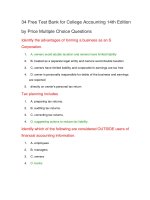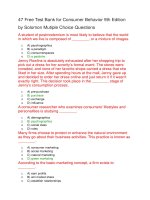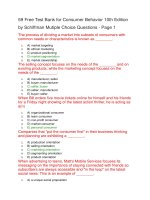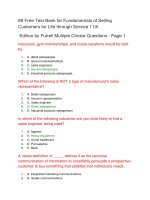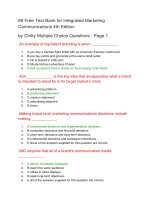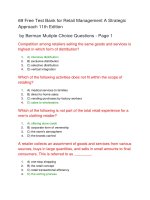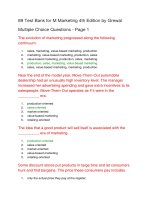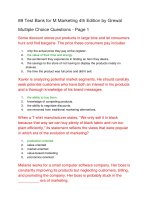69 free test bank for contemporary marketing 14th edition
Bạn đang xem bản rút gọn của tài liệu. Xem và tải ngay bản đầy đủ của tài liệu tại đây (42.65 KB, 12 trang )
69 Free Test Bank for Contemporary Marketing 14th
Edition
by Boone
Mutiple Choice Questions - Page 1
In the history of marketing, when did the production era end in the
United States?
1.
2.
3.
4.
a.Late 1800s with the mass immigration of skilled workers to America.
b.1920s with the improvement in production capabilities.
c.1960s with the establishment of overseas production facilities.
d.21st century with the introduction of robotics.
An alliance between a not-for-profit organization and a for-profit
organization:
1.
2.
3.
4.
a.rarely benefits either party.
b.often benefits both parties.
c.typically benefits the not-for-profit more than the for-profit.
d.typically benefits the for-profit more than the not-for-profit.
Whirlpool combines metal, rubber, and other components in the
production of appliances. In doing so the company creates _____
utility.
1.
2.
3.
4.
a.ownership
b.form
c.place
d.time
If a company such as J.B. Trucking wanted to avoid marketing
myopia, it should define its business as:
1.
2.
3.
4.
a.transportation solutions.
b.a trucking company.
c.a materials handling company.
d.a freight hauling firm.
Which of the following is now the second-largest market in the
world?
1.
2.
3.
4.
a.United Kingdom
b.China
c.Japan
d.India
A company produces a high-quality product, with a maximum
monthly output of 10,000 units. Production levels are constant and
the company relies on its marketing department to find customers.
This approach is consistent with which era in marketing history?
1.
2.
3.
4.
a.Production era
b.Relationship era
c.Marketing era
d.Sales era
Melissa is campaigning for Janet, her friend, who is contesting for
the presidency of the student council at Riverdale Junior College.
Melissa’s effort is an example of _____ marketing.
1.
2.
3.
4.
a.cause
b.person
c.place
d.organization
In the relationship era, firms focus on:
1.
2.
3.
4.
a.short term relationships with suppliers.
b.long term relationships with customers and suppliers.
c.short term relationships with customers and suppliers.
d.long term relationships with customers.
A marketing philosophy summarized by the phrase “a good product
will sell itself” is characteristic of the _____ era.
1.
2.
3.
4.
a.production
b.sales
c.marketing
d.relationship
The most obvious distinction between not-for-profit and for-profit
organizations is:
1.
2.
3.
4.
a.for-profits have more exact marketing goals.
b.not-for-profits have a different view of what constitutes the bottom line.
c.customers of not-for-profits have more control.
d.not-for-profits market services not goods.
When you purchase concert tickets over the Internet, which utility is
not created?
1.
2.
3.
4.
a.Place
b.Time
c.Form
d.Ownership
Fame-us is a talent hunt agency focusing on the youth looking to
enter Hollywood. As part of their marketing strategy, Fame-us would
generate time and place utility by:
1.
2.
a.creating a nationwide advertising campaign to attract applicants.
b.launching roadshows across cities and conduct talent hunts at campuses
during Thanksgiving.
3. c.endorsing their services using famous celebrities from Hollywood.
4. d.opening a well-equipped studio with pre and post-production facilities.
A strong market orientation:
1.
2.
3.
4.
a.reflects the adoption by a firm of a sales orientation.
b.is consistent with a production orientation.
c.becomes necessary with a shift from a buyer’s market to a seller’s market.
d.generally improves market success and overall performance.
When did relationship marketing emerge?
1.
2.
3.
4.
a.Mid 1800s, with the limited access to large markets.
b.1920s, with the development of mass production.
c.Mid 1950s, with the advent of television advertising.
d.1990s, with the evolution of the traditional marketing concept.
Not-for-profit organizations often market to _____ and _____ may
interfere with the organization’s marketing program.
1.
2.
3.
4.
a.a single public; stockholders
b.a single public; the government
c.multiple publics; other voluntary organizations
d.multiple publics; major contributors
The emergence of the marketing concept can best be explained
by:
1.
2.
3.
4.
a.higher production levels.
b.a shift from a production to a sales orientation.
c.a shift from a seller’s market to a buyer’s market.
d.a focus on product quality.
Some Florida drivers have license plates that say “Save the
Manatee.” This is an example of _____ marketing.
1.
2.
3.
4.
a.organization
b.cause
c.place
d.event
All of the following are public not-for-profit organizations except:
1.
a.American Cancer Society.
2.
3.
4.
b.Department of Homeland Security.
c.University of Iowa.
d.Federal Trade Commission.
Assume you want to increase the number of customers by applying
the marketing concept. Which of the following strategies would be
most consistent with this approach?
1.
2.
3.
4.
a.Reduce product costs
b.Target markets
c.Offer more product variety than competitors
d.Promote heavily
Approximately, what percentage of new products fails?
1.
2.
3.
4.
a.Less than 10 percent.
b.Between 25 percent and 40 percent
c.Between 50 percent and 65 percent.
d.More than 80 percent.
The future growth of a company is endangered when management:
1.
2.
3.
4.
a.adopts a consumer orientation.
b.is aware of the scope of its business.
c.is committed to maintaining a product-oriented philosophy.
d.is focused on providing benefits rather than producing products.
You receive a flyer urging you to attend a rally for a local political
candidate. You’re asked to bring a can of food for the local food
bank as the “price of admission”. This is a combination of _____
and _____ marketing respectively.
1.
2.
3.
4.
a.event; person
b.event; organization
c.organization; cause
d.person; cause
State bureaus of tourism and conventions typically engage in _____
marketing.
1.
2.
3.
4.
a.organization
b.person
c.place
d.cause
The utility of a product or service is its:
1.
2.
3.
a.want-satisfying power.
b.re-usability.
c.function as a commodity.
4.
d.design quality.
A buyer’s market is characterized by:
1.
2.
3.
4.
a.more goods and services than buyers to buy them.
b.more buyers than available goods and services.
c.practically no competition in the marketplace.
d.slow economic growth.
Which of the following statements is not correct regarding not-forprofit organizations?
1.
a.There are more than 1.5 million not-for-profit organizations in the United
States.
2. b.Nearly 10 percent of the workforce works for or volunteers at not-for-profits.
3. c.Not-for-profit organizations are all found in the public sector.
4. d.Not-for-profits sometimes form strategic alliances with for-profit companies.
Governmental units and agencies:
1.
2.
3.
4.
a.are not considered not-for-profit organizations.
b.pursue objectives that may or may not be authorized by law.
c.are expected to at least break even.
d.are generally funded from tax collections.
Which of the following factors contributed to the transition from the
production era to the sales era?
1.
2.
3.
4.
a.Increased consumer demand
b.More sophisticated production techniques
c.Increase in urbanization
d.The Great Depression
Convenience stores and vending machines create all of the
following utilities except:
1.
2.
3.
4.
a.ownership utility.
b.form utility.
c.time utility.
d.place utility.
Comparing not-for-profit organizations with for-profit organizations,
all of the following statements are correct except:
1.
a.not-for-profit organizations can be impacted by contributors’ personal
agendas.
2. b.not-for-profit organizations may market both tangible goods and services.
3. c.not-for-profit organizations depend on strategic alliances with for-profits to
provide advertising and visibility.
4. d.not-for-profit organizations must try to find ways to market their services in a
cost-effective manner.
The following statements concerning the global marketplace are
true except:
1.
2.
3.
a.The global marketplace is growing because of Internet technology.
b.The global marketplace is growing because of trade agreements.
c.The global marketplace is growing because no single country can
manufacture, supply, and consume all that it produces.
4. d.The global marketplace is growing owing to talent shortage in the home
countries of national companies.
The basic objective of place marketing is to:
1.
2.
3.
4.
a.attract visitors or new businesses to a particular area.
b.influence others to accept the goals of the sponsoring organization.
c.convince people to attend a sporting or cultural event.
d.bring to the attention of the public some charitable issue.
All of the following are examples of nontraditional marketing except
_____ marketing.
1.
2.
3.
4.
a.political
b.cause
c.event
d.organization
A music star promotes her concerts, but also uses her concerts to
promote a charitable cause. This is an example of a combination of
_____, _____, and _____ marketing respectively.
1.
2.
3.
4.
a.event; person; time
b.cause; person; event
c.person; event; cause
d.person; organization; event
A company with a _____ orientation assumes that customers will
resist purchasing products not deemed essential. Therefore, the
marketing department will need to overcome this resistance through
personal selling and advertising.
1.
2.
3.
4.
a.production
b.marketing
c.sales
d.relationship
69 Free Test Bank for Contemporary Marketing 14th
Edition by Boone Mutiple Choice Questions - Page 2
Relationship marketing focuses more attention on _____ customers
because new customers are _____ to acquire compared to existing
customers.
1.
2.
3.
4.
a.existing; less expensive
b.new; less expensive
c.existing; more expensive
d.new; more expensive
By contributing to local scholarships and community programs,
which type of behavior is Target Stores exhibiting?
1.
2.
3.
4.
a.Relationship marketing
b.Social responsibility
c.Green marketing
d.One-to-one marketing
The facilitating functions of marketing include:
1.
2.
3.
4.
a.securing marketing information and risk taking.
b.buying and selling.
c.transportation and storage.
d.typing and separation.
When Best Buy sells a new television or DVD player, it is
performing the _____ function.
1.
2.
3.
4.
a.facilitating
b.buying
c.distribution
d.risk taking
The application of relationship marketing requires attention to levels
of customer loyalty. Which of the following is the highest level as
defined by this type of marketing?
1.
2.
3.
4.
a.Loyal supporter of the company and its goods and services.
b.Advocate who not only buys the products but recommends them to others.
c.Regular purchaser of the company's products.
d.Stockholder who literally buys into the organization and its mission.
Buying and selling are:
1.
2.
3.
4.
a.the two exchange functions of marketing.
b.physical distribution functions.
c.exchange and distribution functions, respectively.
d.distribution and exchange functions, respectively.
In the practice of relationship marketing, the definition of a customer
is taken to another level. Which of the following best illustrates how
a company practicing relationship marketing might differ from a
traditional transaction-based marketer?
1.
2.
3.
a.The city pool allows kids 12 years and younger to swim free on Fridays.
b.A local coffee shop distributes coupons for $.50 off each cup of coffee.
c.The purchasing department of a defense contractor invites its suppliers to
attend an annual golf outing.
4. d.The heads of the financial departments meet with the Chief Financial Officer
to discuss year-end financial reporting.
What is the ultimate objective of one-to-one marketing?
1.
2.
3.
4.
a.Find new customers
b.Create regular purchasers
c.Turn customers into advocates
d.Turn customers into loyal supporters
Ethics refers to:
1.
2.
3.
4.
a.the code of conduct for managers within organizations.
b.the social causes promoted by the company.
c.the social responsibility of organizations.
d.the moral standards of behavior expected by society.
The physical distribution functions of marketing are:
1.
2.
3.
4.
a.storing and transporting.
b.standardization and grading.
c.financing and risk taking.
d.buying and selling.
The revenues and intangible benefits accrued to the firm, minus the
investment to attract and keep the customer is known as:
1.
2.
3.
4.
a.customer value.
b.intangible benefit stream.
c.investment-benefit differential.
d.lifetime value of the customer.
_____ involves marketing philosophies, policies, procedures and
actions whose primary objective is the enhancement of society.
1.
2.
3.
4.
a.Social responsibility
b.Green marketing
c.Ethics
d.Relationship marketing
What are the subfunctions of physical distribution?
1.
2.
a.Buying, selling, and financing
b.Risk taking and market research
3.
4.
c.Warehousing and transporting
d.Standardizing and grading
The rapid development of telecommunications from Internet to cell
phones allows marketers to accomplish all of the following except:
1.
2.
a.find new markets on a global level.
b.target markets to locate, secure, and maintain customers in a one-to-one
marketing relationship.
3. c.realize improved marketing efficiencies, including lower sales and marketing
costs.
4. d.standardize product lines and marketing promotions to appeal to the largest
possible audience.
An alumni association at a university sends out announcements
promoting the homecoming football game and an alumni
association function. This is an example of a combination of _____
and _____ marketing.
1.
2.
3.
4.
a.event; person
b.event; organization
c.person; organization
d.event; place
All of the following statements about strategic alliances are correct
except:
1.
a.Strategic alliances can be formed by both for-profit and not-for-profit
organizations.
2. b.All strategic alliances end up benefiting one organization more than another.
3. c.Strategic alliances are designed to create competitive advantages.
4. d.Strategic alliances can be vertical or horizontal in nature.
Schwann’s Foods sells its products through both grocery stores and
door-to-door sales. Selling, order taking, delivery and limited
customer service are all conducted by the drivers. Which two
marketing functions overlap as a result of the drivers’ required
responsibilities?
1.
2.
3.
4.
a.Facilitation and distribution
b.Exchange and facilitating
c.Distribution and exchange
d.Exchange and financing
Which is not a facilitating function of marketing?
1.
2.
3.
a.Standardizing
b.Financing
c.Risk taking
4.
d.Securing media information
An example of interactive media marketing would be:
1.
a.a customer having input in creating their own products, such as Subway or
Build-a-Bear.
2. b.an intermediary wholesaler who links sale of goods from manufacturer to
consumer.
3. c.buyer-seller communication through the Internet, virtual reality kiosks, and
CD-ROMs.
4. d.Consumer Reports.
GMAC provides credit to GM dealers, as well as buyers. This is an
example of:
1.
2.
3.
4.
a.financing function.
b.exchange function.
c.distribution function.
d.securing marketing information.
Tyson Foods promoting the “Share Our Strength” program is an
example of _____ marketing.
1.
2.
3.
4.
a.event
b.person
c.cause
d.place
As an official sponsor of the Olympics, the Coca-Cola Company
engages in _____ marketing.
1.
2.
3.
4.
a.place
b.event
c.person
d.organization
When marketers apply quantity control standards, they are:
1.
2.
3.
4.
a.engaging in the process of exchange.
b.reducing the need for purchasers to inspect each item they purchase.
c.determining the amount an individual will be allowed to buy on credit.
d.developing channels of distribution for a product.
Relationship marketing relies heavily on:
1.
2.
3.
4.
a.mass marketing and global promotions.
b.technology to store customer data and to customize products/services.
c.strategic alliances and creating competitive advantages.
d.aligning business goals with a social cause.
Marketers are responsible for three primary marketing functions,
which are further divided into eight sub-functions. Which of the
following is not one of the primary functions?
1.
2.
3.
4.
a.Facilitating
b.Physical distribution
c.Servicing
d.Exchange
A biotechnology company and a university medical school work to
develop a new drug to treat arthritis. This is an example of:
1.
2.
3.
4.
a.a joint marketing agreement.
b.marketing research.
c.a one-to-one marketing program.
d.a strategic alliance.
By converting indifferent customers into loyal ones through
relationship marketing, companies can:
1.
2.
a.increase the cost of maintaining existing customers.
b.start a process by which customers become bound contractually to the
business.
3. c.avoid the necessity of improving customer service in the long run.
4. d.generate repeat sales.
Many hotel chains offer free stays and other perks to repeat
customers. This is an example of:
1.
2.
3.
4.
a.relationship marketing.
b.transaction-based marketing.
c.team marketing.
d.a strategic alliance.
Interactive marketing refers to:
1.
a.sequential marketing efforts beginning with frontline salespersons and
proceeding to detailed instructions by a technical expert.
2. b.marketing efforts vis-a-vis interactive programs where customers can post
their queries directly to the management.
3. c.buyer–seller communications in which the customer controls the amount
and type of information received from a marketer.
4. d.software-controlled marketing strategy which uses central databases to
segment the market on various demographic and psychographic factors.
Approximately, _____ of large companies offer some sort of ethics
training for workers?
1.
2.
a.less than 25 percent
b.one-third
3.
4.
c.ten percent
d.more than half
Sally Myers, head of marketing at Sally’s Salon, serviced six new
customers over the past two weeks. Through a feedback form, Sally
learnt that all of them had acted upon the opinions of their friends
and family members. What Sally encountered is an example of:
1.
2.
3.
4.
a.interactive marketing success.
b.effective target market strategies.
c.marketing myopia.
d.a success story in buzz marketing.
The selling function of marketing involves:
1.
2.
3.
4.
a.making sufficient quantities of goods available in the marketplace.
b.ensuring products meet established quality and quantity standards.
c.securing marketing information.
d.using advertising, personal selling, and sales promotion to match goods and
services to customers.
Which of the following is a facilitating function of marketing?
1.
2.
3.
4.
a.Buying
b.Selling
c.Standardization and grading
d.Distribution
Financing is one of the _____ functions.
1.
2.
3.
4.
a.exchange
b.pricing
c.commercial
d.facilitating
